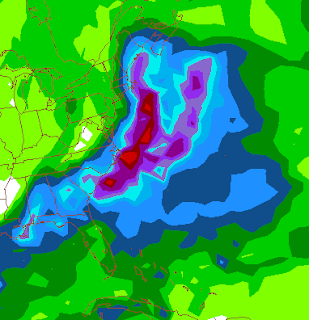Surface low from the Gulf of Mexico across east NC to near the Delmarva. It is a little disjointed from the upper air low but does drop between .25 and a half inch of rain. As the upper air support approaches we flip to snow. Its taking an ideal track as modeled. It doesn't have to do that--so there is some open chances this changes. We have plenty of wiggle room from the south--as some of the data first plaster Winston Salem and move it Northeast at us.
Between a half inch and literally an inch of liquid can fall in the snow band-- considering its wet snow, 4-8 inches. Attached is a graphic from the model output-- it can be hard to read. First column I've marked is surface temps. Second is temp at 5k feet and third is liquid that falls.
The air is chilly and raw. As the upper air low approaches from the west, the air cools, which had been running from about 35-40 degrees from 5k feet down rapidly cools. The light drizzle suddenly has huge rain drops mixing and rather quickly the rain becomes heavy. The TV breaks in and announces 8+ inches has fallen in places in North Carolina and heavy snow is now falling in Blacksburg, Roanoke and Martinsville. Perhaps a quick rumble of thunder and suddenly a flake of snow appears. Quickly, more and more snow mixes in and suddenly it all snow. Surface temps drop to 32 and flakes the size of pancakes are falling. Heavy snow lasts for 2-6 hours. While flapjacks no longer fall from the sky, such large flakes, the size of silver dollars are not often witnessed around this parts. With the wet nature of the snow, everything is plastered. Trees branches that stand tall in the sun now scrap the ground under the heavy weight of the snow. As quickly as it started, the snow has tapered to just flurries.
This upper air energy is similar to the March 1-2 09 event. That event was much colder and we had snow on the front side. The upward motion in the clouds was so great that before the second band of snow came in--we had 20 minutes of graupel where the fast upward movement precluded the snow growth.
Pic from that event-- this is in the two hours were 5 inches fell.
 |
| 12:30 AM March 2, 2009. |
Will do a full update after tonights model data-- as of now, our odds for 4-8 inches sits at about 60%








